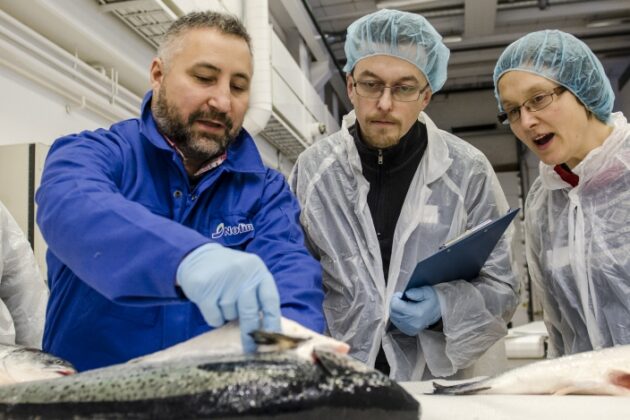Seafood quality

In this multi-disciplinary project we have studied the entire value chain for mackerel and farmed salmon.
Start
01. Mar 2015
End
28. Feb 2019
Funded by
Nofima
Project Manager(s):
Other Participants:
Themistoklis Altintzoglou
Kathryn Anderssen
Lidunn Mosaker Boge
Laila Budal
Tor Hatten Evensen
Karsten Heia
Anette Hustad
Audun Iversen
Sjurdur Joensen
Gro Haugvaldstad Kleiberg
Silje Kristoffersen
Trond Karsten Løvdal
Thomas Nyrud
Stein Harris Olsen
Ingelinn Eskildsen Pleym
Roy Robertsen
Tone Mari Rode
Bjørn Tore Rotabakk
Bjørn Roth
Aase Vorre Skuland
Torstein Skåra
Geir Sogn-Grundvåg
Wilhelm Andreas Solheim
Runar Gjerp Solstad
Izumi Sone
Marianne Svorken
Tina H.E. Thesslund
Torbjørn I Tobiassen
Birthe Vang
Gøril Voldnes
Objective
The objective of the project was to:
- Develop tools and methods for safeguarding seafood quality throughout the entire value chain
- Strengthen Nofima’s expertise and position with regards to seafood quality
- Develop a basis for multidisciplinary applications
- Increase the dissemination of research on seafood quality
This project has strengthened the Nofima researchers’ expertise on seafood quality throughout the value chain for salmon and mackerel. Both market researchers, business economists, biotechnologists and seafood industry researchers from Nofima have gained increased insights into the quality characteristics of mackerel, food safety, high-pressure processing, the utilization of residual biomass from the pelagic sector, hyperspectral imaging, the value chain for mackerel, mackerel auctions and various market aspects.
For salmon we have gained further insights into how the quality is affected by the various seasons, localities, filleting and storage; whole-salmon quality analyses; food safety; high pressure treatment and hyperspectral imaging; as well as deeper knowledge about diploid and triploid salmon.
Research results for mackerel:
- Which factors affect quality, food safety and storage stability for mackerel?
- Mackerel auctions: Insights in to price drivers
- Increased knowledge about large buyers at mackerel auctions
- Photo box for fish auctions
- How do Japanese consumers prefer their Norwegian mackerel?
- Hydrolysis of mackerel
- Extraction and value creation from water outlets in the pelagic sector
Research results for salmon:
- How different seasons, localities, filleting and storage affect the quality of salmon
- Quality characteristics and consumer acceptance of diploid and triploid smoked salmon
- Whole-salmon quality analyses
- Cold storage of salmon and rainbow trout – quality and durability
Other research findings:
- Quality and high-pressure treatment of cod, salmon and mackerel
- Shelf life and high-pressure treatment of cod, salmon and mackerel
- Detection of blood in fish muscle by hyperspectral imaging
- Identifying pin bone attachment in fish fillets using High Intensity Focused Ultrasound (HIFU)
- Assessment of packaged cod freeze-thaw history by hyperspectral imaging
- New insights on profitability and market potential for residual biomass
- Increased knowledge about Listeria monocytogenes in mackerel and salmon
Method development
We have employed the following methods:
- Hybrid open-ended questions
- Blood analyses and on-line data analyses
- Competence building in rheology and the use of a rheometer
- Salt analyses of mackerel
- Colour analyses with DigiEye – Part 2: Analysis
- New gene expression analysis methods
- Whole-salmon quality analyses
- Quick sensory method for assessing salmon: The objective of this work was to evaluate possible quick methods for sensory assessment of boiled salmon. We tested the TDS (Temporal Dominance of Sensation) and TCATA (Temporal-Check-All-That-Apply) methods.
- TBARS analysis (rancidity) of mackerel
- Smoking methods for mackerel
- Product development and employment of newer technologies for hydrolyses of residual biomass
- Multi Locus VNTR Analysis and Multi Locus Sequence Typing of Listeria (START2 software)
- Microscoping (muscle structure)
- Product and process development with molecular gastronomy
- Product development with fish proteins
- Developing a new analysis methodology for detecting blood in fish muscle.
Dissemination
We have also focused on communicating research on seafood quality in an easily accessible way through:
- Various seminars for the business community, colleagues and the general public
- The blog “Fra fjord til bord” about seafood research
- A video blog on seafood quality
Film about mackerel
Publications
Research areas